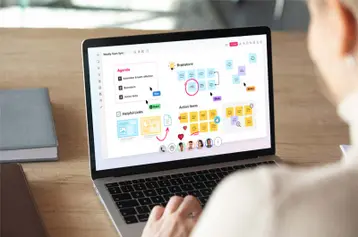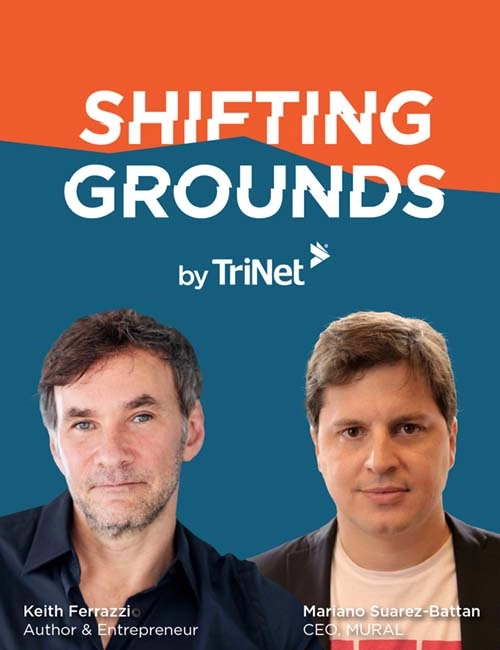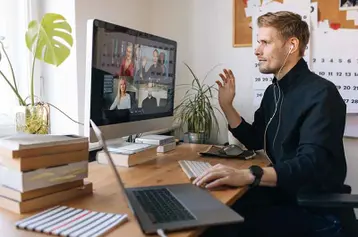Breaking Through the 3 Myths of Remote Collaboration

Table of contents
- 1.Remote Collaboration Myth #1: Meetings and collaboration are synonymous.
- 2.Increase collaboration by respecting your colleagues’ time.
- 3.Hear the Shifting Grounds Podcast
- 4.Remote Collaboration Myth #2: More meetings and more attendees aren’t necessarily better.
- 5.Remote Collaboration Myth #3: Culture can only be built if we're in the same building together.
- 6.Design Your Time Together
In our Shifting Grounds podcast, host Keith Ferrazzi discusses reinventing the way we work with Mariano Suarez-Battan cofounder and CEO of MURAL. MURAL enables innovative teams to think and collaborate visually to solve problems anytime, anywhere. “It wasn't just about the whiteboard. It was about the whiteboard, combined with methodologies, combined with being enterprise-class,” says Suarez-Battan. Ferrazzi refers to it as “a thinking canvas.”
Ferrazzi and Suarez-Battan take a deep dive into how the old ways of working have been rooted in industrial-era thinking and how businesses can effectively use radical adaptability to redesign today’s workplace. The discussion brings to light three remote collaboration myths that have kept small and medium-size businesses (SMBs) from embracing the benefits of a remote workforce.
Remote Collaboration Myth #1: Meetings and collaboration are synonymous.
Collaboration does not equal meetings. A study by McKinsey found that most executives frequently find themselves spending way too much time on pointless interactions that drain their energy and produce information overload.1
Suarez-Battan believes that people are starting to understand that meetings are about achieving outcomes. He says meetings can fall into several outcome categories or a combination of these:
- Informative: Letting you know about something new
- Evaluative: Someone is pitching and someone is deciding
- Generative: The group builds on top of each other’s ideas to create or understand something new together
Suarez-Battan says that the key to success is being prepared for the meeting in advance. For example, instead of having a meeting with 20 people where one person speaks for 10 minutes, he suggests recording a video in advance that attendees can watch on their own time and come to the meeting with that knowledge. This helps minimize meeting overload and maximizes the time you have to collaborate.
Ferrazzi suggests that in addition to the video, the meeting organizer could open a MURAL board or some form of a collaborative space. That way, people start to comment in a structured fashion before the meeting starts. This could include questions about the video, potential challenges or other solutions that might be considered. With the approach, the organizer has the ability to orchestrate the meeting much more effectively, because much of the collaboration has already taken place.
Many of the currently accepted collaboration steps fell into place over the years. For example, Ferrazzi notes that the meeting after the meeting was a part of the collaboration that would happen as you're walking down the hall. And yet now we need to be much more intentional, much more purposeful and more orchestrated. Otherwise, we will suffer in this remote mindset or in this remote environment. He suggests that the after-the-meeting meeting could take place by setting up a chat channel for attendees to discuss ideas and questions that arose after the meeting. He says, “A lot of people have been pointing to data that said, remote is less effective because it's less innovative or it's less connected. That is true if you do it poorly. And I think the issue is we really need to be doing it intentionally.”
Suarez-Battan adds, “The fact that we are having this conversation is a symptom of the post-pandemic world also, right? We are studying how we work much more than we were before. Before we assume, okay, let's go to the office, culture happens. Let's get inside a room. Ideas happen. And not really.” He continues, “I think that what we're starting to realize is that it's not just about teleporting people anymore. It's not about the teleporting the ideas anymore. It's about how we design our time together.”
Increase collaboration by respecting your colleagues’ time.
- Consider recording a video that attendees can watch in advance to get background and an overview of meeting objectives.
- Use an online drawing board to let attendees comment and make suggestions before the meeting takes place
- Set up a chat channel for attendees to discuss ideas and questions after the meeting
Hear the Shifting Grounds Podcast
Host Keith Ferrazzi discusses maximizing remote collaboration with Mariano Suarez-Battan CEO of MURAL.
Remote Collaboration Myth #2: More meetings and more attendees aren’t necessarily better.
A common belief is that the more people you get involved in collaboration, the slower the process is and the more watered down it becomes. Even so, this was the accepted way to make business processes more consensus-oriented. Ferrazzi says that in the “olden days,” we used to think, "Well, let's keep the collaboration team tight and let's figure it out. And then we'll go get buy-in. We'll go acclimate after that.”
“The right amount of people, the right situation,” says Suarez-Battan. “It needs to be really clear who does what. When you call a meeting of 20 people make sure that, again, you're purposely designing.” He says meetings are steps in a journey towards defining and communicating a strategy. “I think that what people are starting to understand is that, yes, it's about achieving outcomes, right? So, one of the steps you take towards achieving an outcome is having a meeting. But again, meetings are called to also achieve a micro-outcome.”
There are moments in workflow progression when you need synchronicity. This is where Suarez-Battan says you need to prepare for the meeting in advance. “I think that what we're starting to realize is that it's not just about teleporting people anymore. It's not about the teleporting the ideas anymore. It's about how we design our time together.” Ferrazzi adds, “I think if any of us are thinking about starting to host physical meetings again, whenever that is, of course, we are by now, make sure that you don't do the same thing you did in a remote meeting and just think it's better because of it. You're going to get a lot of resentment from people who are thinking, ‘Why did you bring me in here for this?’” He continues, “I feel that when we're in-person, we've got to value the emotional connectivity that would be riper in-person. So, make sure that the agendas are going to lean into those emotional positive and negative items most effectively.”
Suarez-Battan compares the process to choreography. “It's not about the office space, not about the facilities or even the video conferencing software they use, that's important, that teleports people and puts them there, but it's about the time together.”
Remote Collaboration Myth #3: Culture can only be built if we're in the same building together.
The proverbial water cooler and the ping pong table were once considered foundational tools for culture building.
“I always get into trouble with banking leaders, because they always have an apprenticeship culture,” says Suarez-Battan, “And so basically, it's people interrupting others so they can learn via osmosis, right? They put them all together and assume that they're learning, because again, they can mimic each other versus being more thoughtful about it.”
Ferrazzi says culture is built through belonging, a sense of trust and connectedness. “If we are in a physical room together, but all we're doing is small talk, sure, there's some degree of intimacy, some degrees of empathy, some degree of care that's concerned. But what if we're in a virtual room and we become intentional?” he asks.
“It's being more present and aware, I think, and designing our time together,” answers Suarez-Battan. “If you have the luxury of being in the same room, okay, even better, right? But being intentional about that, and not expect serendipity to just happen or through small talk make connections.”
Design Your Time Together
Competing in this new business world requires radical adaptability. Historically, the office was a solution to a problem of putting people together to do the work. Suarez-Battan says it was an incremental solution from the factory. The factory was needed because there was specialized machinery. Then the office was also needed because now there are security and documents. Now we have the cloud and other technology and all of a sudden, that solution to the problem around connecting people's minds, helping them think and come up with new ideas or make decisions happen has become obsolete and also brings a lot of constraints.
“I think that we're providing a solution to a problem of making people feel more connected,” says Suarez-Battan, “Imagining and imagining together and understanding problems and solving problems together—I think that the things that we're putting together help people bring their full selves, teams can be formed and they can be taking most advantage of their time together. I'm very excited... we're fortunate to be working on these problems together.”
1 “The need for speed in the post-COVID-19 era—and how to achieve it,” McKinsey & Company (2020).
In our Shifting Grounds podcast, host Keith Ferrazzi discusses reinventing the way we work with Mariano Suarez-Battan cofounder and CEO of MURAL. MURAL enables innovative teams to think and collaborate visually to solve problems anytime, anywhere. “It wasn't just about the whiteboard. It was about the whiteboard, combined with methodologies, combined with being enterprise-class,” says Suarez-Battan. Ferrazzi refers to it as “a thinking canvas.”
Ferrazzi and Suarez-Battan take a deep dive into how the old ways of working have been rooted in industrial-era thinking and how businesses can effectively use radical adaptability to redesign today’s workplace. The discussion brings to light three remote collaboration myths that have kept small and medium-size businesses (SMBs) from embracing the benefits of a remote workforce.
Remote Collaboration Myth #1: Meetings and collaboration are synonymous.
Collaboration does not equal meetings. A study by McKinsey found that most executives frequently find themselves spending way too much time on pointless interactions that drain their energy and produce information overload.1
Suarez-Battan believes that people are starting to understand that meetings are about achieving outcomes. He says meetings can fall into several outcome categories or a combination of these:
- Informative: Letting you know about something new
- Evaluative: Someone is pitching and someone is deciding
- Generative: The group builds on top of each other’s ideas to create or understand something new together
Suarez-Battan says that the key to success is being prepared for the meeting in advance. For example, instead of having a meeting with 20 people where one person speaks for 10 minutes, he suggests recording a video in advance that attendees can watch on their own time and come to the meeting with that knowledge. This helps minimize meeting overload and maximizes the time you have to collaborate.
Ferrazzi suggests that in addition to the video, the meeting organizer could open a MURAL board or some form of a collaborative space. That way, people start to comment in a structured fashion before the meeting starts. This could include questions about the video, potential challenges or other solutions that might be considered. With the approach, the organizer has the ability to orchestrate the meeting much more effectively, because much of the collaboration has already taken place.
Many of the currently accepted collaboration steps fell into place over the years. For example, Ferrazzi notes that the meeting after the meeting was a part of the collaboration that would happen as you're walking down the hall. And yet now we need to be much more intentional, much more purposeful and more orchestrated. Otherwise, we will suffer in this remote mindset or in this remote environment. He suggests that the after-the-meeting meeting could take place by setting up a chat channel for attendees to discuss ideas and questions that arose after the meeting. He says, “A lot of people have been pointing to data that said, remote is less effective because it's less innovative or it's less connected. That is true if you do it poorly. And I think the issue is we really need to be doing it intentionally.”
Suarez-Battan adds, “The fact that we are having this conversation is a symptom of the post-pandemic world also, right? We are studying how we work much more than we were before. Before we assume, okay, let's go to the office, culture happens. Let's get inside a room. Ideas happen. And not really.” He continues, “I think that what we're starting to realize is that it's not just about teleporting people anymore. It's not about the teleporting the ideas anymore. It's about how we design our time together.”
Increase collaboration by respecting your colleagues’ time.
- Consider recording a video that attendees can watch in advance to get background and an overview of meeting objectives.
- Use an online drawing board to let attendees comment and make suggestions before the meeting takes place
- Set up a chat channel for attendees to discuss ideas and questions after the meeting
Hear the Shifting Grounds Podcast
Host Keith Ferrazzi discusses maximizing remote collaboration with Mariano Suarez-Battan CEO of MURAL.
Remote Collaboration Myth #2: More meetings and more attendees aren’t necessarily better.
A common belief is that the more people you get involved in collaboration, the slower the process is and the more watered down it becomes. Even so, this was the accepted way to make business processes more consensus-oriented. Ferrazzi says that in the “olden days,” we used to think, "Well, let's keep the collaboration team tight and let's figure it out. And then we'll go get buy-in. We'll go acclimate after that.”
“The right amount of people, the right situation,” says Suarez-Battan. “It needs to be really clear who does what. When you call a meeting of 20 people make sure that, again, you're purposely designing.” He says meetings are steps in a journey towards defining and communicating a strategy. “I think that what people are starting to understand is that, yes, it's about achieving outcomes, right? So, one of the steps you take towards achieving an outcome is having a meeting. But again, meetings are called to also achieve a micro-outcome.”
There are moments in workflow progression when you need synchronicity. This is where Suarez-Battan says you need to prepare for the meeting in advance. “I think that what we're starting to realize is that it's not just about teleporting people anymore. It's not about the teleporting the ideas anymore. It's about how we design our time together.” Ferrazzi adds, “I think if any of us are thinking about starting to host physical meetings again, whenever that is, of course, we are by now, make sure that you don't do the same thing you did in a remote meeting and just think it's better because of it. You're going to get a lot of resentment from people who are thinking, ‘Why did you bring me in here for this?’” He continues, “I feel that when we're in-person, we've got to value the emotional connectivity that would be riper in-person. So, make sure that the agendas are going to lean into those emotional positive and negative items most effectively.”
Suarez-Battan compares the process to choreography. “It's not about the office space, not about the facilities or even the video conferencing software they use, that's important, that teleports people and puts them there, but it's about the time together.”
Remote Collaboration Myth #3: Culture can only be built if we're in the same building together.
The proverbial water cooler and the ping pong table were once considered foundational tools for culture building.
“I always get into trouble with banking leaders, because they always have an apprenticeship culture,” says Suarez-Battan, “And so basically, it's people interrupting others so they can learn via osmosis, right? They put them all together and assume that they're learning, because again, they can mimic each other versus being more thoughtful about it.”
Ferrazzi says culture is built through belonging, a sense of trust and connectedness. “If we are in a physical room together, but all we're doing is small talk, sure, there's some degree of intimacy, some degrees of empathy, some degree of care that's concerned. But what if we're in a virtual room and we become intentional?” he asks.
“It's being more present and aware, I think, and designing our time together,” answers Suarez-Battan. “If you have the luxury of being in the same room, okay, even better, right? But being intentional about that, and not expect serendipity to just happen or through small talk make connections.”
Suarez-Battan says that this is where having diverse people from diverse cultures can be invaluable. “So, that's another beauty of remote, right? You have people, different cultures from anywhere they might be, growing up from different backgrounds contributing to the most interesting problems.”
Design Your Time Together
Competing in this new business world requires radical adaptability. Historically, the office was a solution to a problem of putting people together to do the work. Suarez-Battan says it was an incremental solution from the factory. The factory was needed because there was specialized machinery. Then the office was also needed because now there are security and documents. Now we have the cloud and other technology and all of a sudden, that solution to the problem around connecting people's minds, helping them think and come up with new ideas or make decisions happen has become obsolete and also brings a lot of constraints.
“I think that we're providing a solution to a problem of making people feel more connected,” says Suarez-Battan, “Imagining and imagining together and understanding problems and solving problems together—I think that the things that we're putting together help people bring their full selves, teams can be formed and they can be taking most advantage of their time together. I'm very excited... we're fortunate to be working on these problems together.”
1 “The need for speed in the post-COVID-19 era—and how to achieve it,” McKinsey & Company (2020).

TriNet Team
Table of contents
- 1.Remote Collaboration Myth #1: Meetings and collaboration are synonymous.
- 2.Increase collaboration by respecting your colleagues’ time.
- 3.Hear the Shifting Grounds Podcast
- 4.Remote Collaboration Myth #2: More meetings and more attendees aren’t necessarily better.
- 5.Remote Collaboration Myth #3: Culture can only be built if we're in the same building together.
- 6.Design Your Time Together






